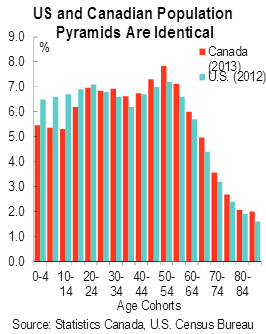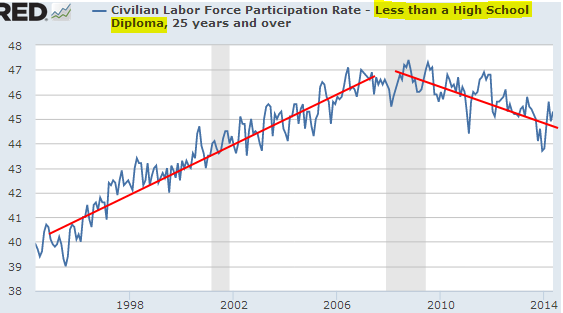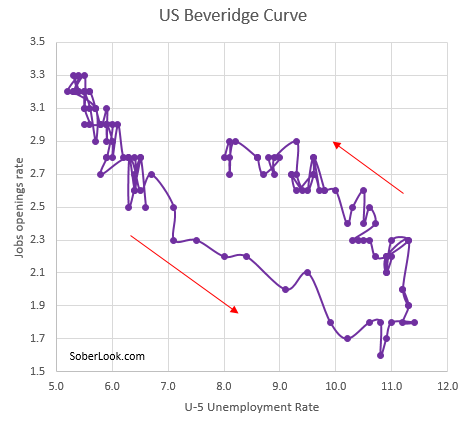Debate among economists around the drivers of declining labor force participation in the US has intensified. How much of the decline since the Great Recession is from the demographic effects of aging population and how much is due to disillusioned workers giving up on job searches and "dropping out" of the workforce? The answer is not obvious, since the participation rate has peaked around the year 2000 and had started declining years before the Great Recession.
First, a bit of background. The reason for the rise in labor force participation between the early 60's and the end of the 20th century is mostly due to women entering the workforce as well as Americans starting to work longer before retiring. This brought a larger portion of the population into the workforce, increasing the participation rate. But as the baby-boomers began to retire, the participation rate started to decline.
The answer to this question has significant implications for the Fed's monetary policy trajectory because it is a major determinant of the amount of slack in US labor markets. Decisions on the timing of rate hikes will depend to a great extent on whether the labor market has become sufficiently tight to generate wage pressures. And if companies can draw on a large pool of workers who had left the labor force, it will be a while before wage growth begins to accelerate.
The best way to answer this question of demographic effects on the participation rate is to find a "control" country. It would need to be a nation that has a very similar demographic distribution to the US but had not been as severely impacted by the Great Recession. Scotiabank's Derek Holt argues that Canada is indeed such a country. Canada's so-called population pyramid is very similar to the US.
At the same time, Canada's experience with the Great Recession was not nearly as severe. Reasons include Canada's commodity boom, far less aggressive mortgage lending, a better capitalized banking system, a milder housing boom, less fiscal tightening, etc. The labor force participation rates of the two nations have diverged dramatically after the Great Recession.
This shows that the decline in the US participation rate has indeed been driven more by cyclical factors rather than by the demographics. In fact, the economic difficulties that Canada experienced in the 1990s created a sharp dip in participation (chart above) - which again argues for the labor force participation being a cyclical effect.
Problem solved? Not quite. It turns out that the severity of the impact on participation due to cyclical factors varies materially across the population groups. Here is an illustration. The chart below shows labor force participation for workers with a bachelor's degree or higher (that are 25 and older.) The downward trend over the past 20 years is relatively stable and exhibits only a minor impact of the Great Recession. This is mostly demographics - baby-boomers with a college degree retiring as they get older.
In contrast, let's take a look at the population group without a high school diploma. The Great Recession had a significant impact on the participation trend among these workers. This effect is clearly far more cyclical in nature.
We could think of the US labor markets as consisting of two distinct pools of workers: skilled and unskilled. And while the unskilled workers are leaving the labor force, the skilled labor market is starting to tighten. That's part of the reason for the persistent mismatch between job openings and the unemployment/marginal employment rate - the so-called Beveridge Curve. Many openings represent roles that are specialized - particularly in sectors such as healthcare - and can not be easily filled even with vast numbers of Americans in need of work.
And US firms increasingly need workers that are highly specialized - in part because "commoditized" labor skills can be obtained cheaper offshore. This means that we could have wage increases across a number of sectors, particularly in urban areas - in spite of the declining participation rate. We saw signs of that in the rising unit labor costs last quarter, which came as a surprise to some economists (see chart). The effect also showed up in the Fed's Beige Book.
WSJ: - Rising demand for skilled workers could push up salaries across more sectors of the U.S. economy, according to the Federal Reserve's latest survey of regional economic conditions. ... Companies in several regions reported difficulty filling jobs for highly skilled and upper-management positions.
Derek Holt is right. The overall decline in US labor participation rate has certainly been more heavily impacted by the economic downturn in recent years rather than the demographics. But the effect of the downturn has been highly uneven, and while the overall labor market slack is significant, it varies materially across the skills spectrum. Millions of skilled workers lost their jobs in the recession, but a much smaller percentage of them completely dropped out of the work force for economic reasons. That unfortunately was not the case with the "unskilled" population. This "skills divide" of the US labor force has widened the wage gap, leaving large groups of Americans behind. And if the skilled labor force continues to shrink due to aging, this gap will only continue to widen.





